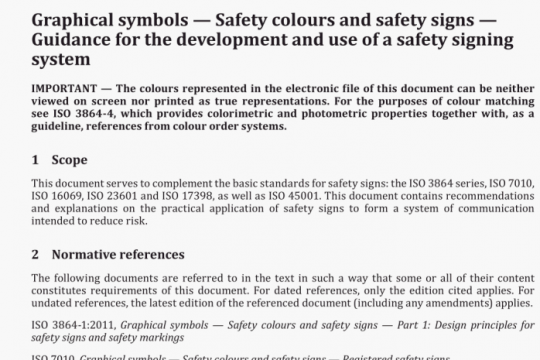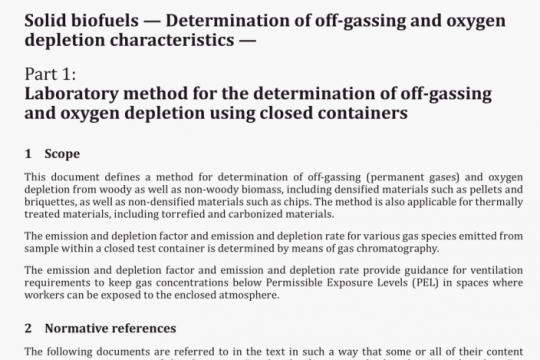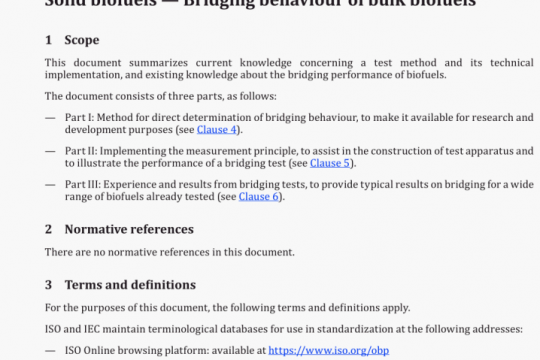ISO 6798-2 pdf free download
ISO 6798-2-2020 pdf free download.Reciprocating internal combustion engines – Measurement of sound power level using sound pressure一 Part 2: Survey method.
5.2 Calibration
Before and after each series of measurements, a sound calibrator meeting the requirements of IEC 60942, class I shall be applied to each microphone to verify the calibration of the entire measuring system at one or more frequencies within the frequency range of interest. Without any adjustment, the difference between the readings made before and after each series of measurements shall be less than or equal to 0,5 dB. If this value is exceeded, the results of the series of measurements shall be discarded.
The sound calibrator and the instrumentation system which meet the requirements, and the reference sound source (RSS) that meets the requirements of ISO 6926, shall be verified at intervals in a laboratory making calibrations traceable to appropriate standards.
Unless otherwise specified, the sound calibrator should be calibrated at intervals not exceeding 1 year, the instrumentation system and the reference sound source should be calibrated at intervals not exceeding 2 years.
5.3 Application
To minimize the influence of observers on the noise measurements, the microphones shall be preferably mounted on a rigid frame or stand which is not connected to the vibrating surface, the microphone shall always be oriented in such a way that the angle of incidence of the sound waves is that for which the microphone is calibrated and always be oriented to the centre of the tested object (the measurement unit(s) related to the microphone position).
The sound pressure level shall be measured using an integrating sound level meter. If the sound level meter is used to measure time-weighting sound pressure level, the time-weighting characteristic “S” shall be used for the noise source under test operated in steady condition and the time-weighting characteristic “F shall be used for the noise source under test operated in non-steady condition (e.g. engine operated in the accelerated or decelerated condition). The measured average value can be expressed as the sound pressure level.
The period of stationary measurement for the sound pressure level shall be at least 4 s, 8 s or above is better.
6 Installation and operation conditions
6.1 General
The way the engine under test is installed and operated has a significant influence on the sound power radiated by a noise source. This clause specifies conditions that are intended to minimize variations in the sound power level due to the installation and operating conditions of the noise source under test.
The engine is a multiple noise source, including the following noise sources:
— air-borne noise (this document);
— exhaust gas noise; intake-air noise;
— structure-borne noise.
NOTE For exhaust noise, see ISO 15619; for intake noise, see ISO/TS 19425; for structural noise, see
ISO 13332.
6,2 Installation conditions
The engine to be tested should be installed on the reflecting plane (ground), the distances between the
surface of noise source (reference box) and the wall(s) and the ceiling should be greater than 0,5 m.
The engine noise radiated is affected by the supporting type of engine, connection type with dynamometer equipment and installation height. If the mounting base is rigid, the engine should be resiliently mounted on the base. If the mounting base is resilient, the engine is permitted rigidly mounted on the base. The engine should be resiliently connected with dynamometer equipment. The distance of the engine lowest noise radiation surface (usually is oil pan bottom) and the reflecting plane (the ground) should be less than or equal to 0,5 m.
6.3 Engine conditions and operation conditions
6.3.1 Engine conditions
The engine noise radiated is affected by the auxiliaries which are equipped on the engine; the condition of engine shall meet the requirements of ISO 3046-1. Any air cleaner, exhaust silencer and cooling fan, etc., if equipped, shall be recorded in the report. A gearbox or any driven machinery which load the engine under test should he stated in the report. Noise radiated from any such driven machinery shall be regarded as extraneous noise.
NOTE I For the determination of the sound power level of exhaust noise, see ISO 15619. For special purposes, the test distance starts from the contour of the exhaust pipe and a number of measuring points of two (90° to outlet) can be used although not recommended.
NOTE 2 For the determination of the sound power level of intake noise, see ISO/TS 19425.
If it is essential to use equipment or non-basic auxiliaries (such as a blower for cooling) to do bench test for some engines with specified purposes (such as motorcycles). Noise radiated from this equipment or non-basic auxiliaries shall be regarded as extraneous noise, or this equipment or non-basic auxiliaries shall be temporarily turned off to ensure that the engine can operate normally.
The extraneous noise is a part of background noise; appropriate steps shall be taken to reduce extraneous noise in order to comply with 42. This can be done by shielding or wrapping the structure surface with a heavy material that has low transmission capabilities in the frequency range of the extraneous noise, and by using a muffler to reduce the aerodynamic noise (gas/liquid).ISO 6798-2 pdf download.




